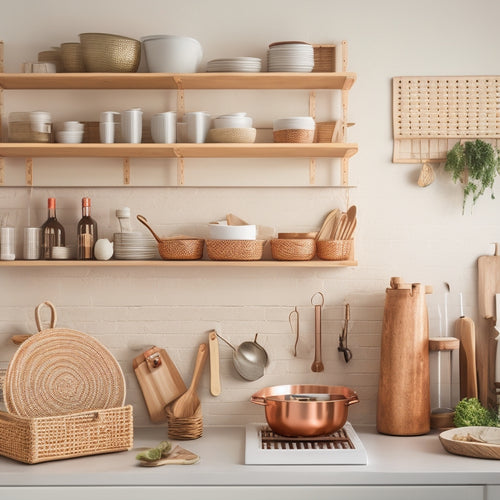
Simplify Kitchen Cleanup With These Pro Tips
Share
You're ready to simplify your kitchen cleanup routine! Start by decluttering your countertops, categorizing items into keep, donate, and toss piles, and organizing appliances for easy access. Next, establish a weekly cleaning schedule, prioritizing high-touch areas and focusing on gentle cleaning practices. Invest in quality cleaning tools, like ergonomic handles and microfiber cloths, to make the task more efficient. By implementing clean-as-you-go strategies and maintaining a stain-free kitchen, you'll reduce stress and save time. Now, take the next step to transform your kitchen into a stress-free zone - and get ready to uncover more expert tips to streamline your cleaning routine!
Key Takeaways
• Declutter and organize your kitchen by sorting items, getting rid of non-essentials, and categorizing items for easy access.
• Establish a weekly cleaning schedule with designated days and times for tasks to maintain cleanliness and efficiency.
• Invest in quality cleaning tools, such as ergonomic handles and microfiber cloths, for effective and sustainable cleaning.
• Prevent stains by cleaning as you go, addressing spills immediately, and using stain-repelling surfaces.
• Implement clean-as-you-go strategies, such as storing items after use and washing dishes promptly, to simplify kitchen cleanup.
Declutter Before You Clean
Sort through the cluttered countertops and get rid of anything that's not essential to your kitchen's functionality before you start scrubbing away. You'll be surprised at how much easier cleaning becomes when you're not maneuvering around a sea of kitchen gadgets and expired condiments.
Kitchen chaos is a real thing, and it's often hiding in plain sight on those cluttered counters.
Take a few minutes to sort items into categories: keep, donate, and toss. Be ruthless – if you haven't used it in the past year, it's probably safe to get rid of it.
Once you've purged your countertops, give them a good wipe down to remove any dust, crumbs, or spills that have accumulated. This will give you a clean slate to work with and make the rest of your cleaning process much more efficient.
Best Practices for Cleaning Kitchen Appliances
Clean your kitchen appliances regularly to prevent the buildup of grease, grime, and bacteria that can compromise their performance and your health. When you clean your appliances, you'll notice they work more efficiently, and you'll reduce the risk of foodborne illnesses.
Start by wiping down exterior surfaces with a damp cloth to remove dust and splatters. Then, tackle interior surfaces, like oven racks and dishwashers, with a gentle cleanser and a scrub brush.
Don't forget about appliance organization – keep your appliances in good working order by storing them in a way that allows for easy access and maintenance. This will also help prevent clutter from building up around your appliances.
Regular filter maintenance is also essential, especially for appliances like dishwashers and refrigerators that rely on filters to function properly. Clean or replace filters as recommended by the manufacturer to guarantee your appliances continue to run smoothly.
Create a Cleaning Schedule
Now that your appliances are sparkling clean, set a routine to maintain their cleanliness and efficiency by allocating specific days and times for kitchen cleanup tasks. This will help you stay on top of messes and prevent them from building up.
To create a cleaning schedule that works for you, consider the following:
-
Establish a weekly routine:
Set aside 15-30 minutes each day to quickly wipe down countertops, sweep/vacuum floors, and clean up after meals. This will keep your kitchen tidy and prevent crumbs and spills from becoming sticky messes. -
Designate deeper cleaning tasks:
Choose one or two days a week to tackle deeper cleaning tasks, such as cleaning the oven, refrigerator, or microwave. -
Schedule seasonal tasks:
Plan to tackle seasonal tasks, like cleaning out the pantry or organizing kitchen cabinets, on a quarterly or bi-annual basis.
Invest in Quality Cleaning Tools
Your kitchen's cleanliness and efficiency rely heavily on having the right arsenal of cleaning tools, which is why investing in a few quality essentials can make all the difference in your cleaning routine. You'll be amazed at how much easier cleaning becomes when you're working with the right tools. For instance, ergonomic handles on your cleaning supplies can reduce fatigue and discomfort, making it easier to tackle those tough messes.
Microfiber cloths are another game-changer. These gentle yet effective cloths can pick up dirt and grime without leaving streaks or residue behind. Plus, they're machine washable, making them a sustainable and cost-effective option.
Focus on High-Touch Areas
Every day, you likely touch dozens of kitchen surfaces, from faucet handles to countertop edges, that can harbor germs and bacteria, making it crucial to prioritize these high-touch areas in your cleaning routine.
These germy zones require special attention to prevent the spread of illness and keep your kitchen clean and hygienic.
To guarantee you're covering all the high-touch areas, conduct a touchpoint analysis of your kitchen. This involves identifying all the surfaces you touch regularly, including:
-
Faucet handles: A breeding ground for bacteria, faucet handles need to be cleaned and disinfected regularly.
-
Countertop edges: These areas are prone to crumbs and spills, making them a haven for germs.
-
Appliance buttons: From the microwave to the dishwasher, these buttons are touched frequently and can harbor germs.
Don't Forget the Little Things
When it comes to kitchen cleanup, you're likely focusing on the big tasks like washing dishes and wiping down counters. However, it's the little things that can make a big difference in the long run.
Clean as You Go
By incorporating cleaning into your cooking routine, you'll save time and energy in the long run. It's all about finding a kitchen rhythm that works for you.
When you clean as you go, you'll avoid that overwhelming mess mindset that can leave you feeling drained at the end of a meal.
Here are three ways to make cleaning a part of your cooking process:
-
Wipe down surfaces: As you finish using a utensil or appliance, quickly wipe it down with a damp cloth. This prevents crumbs and spills from building up and makes cleanup a breeze.
-
Clean ingredients as you go: Chop vegetables and fruits as needed, and discard any waste immediately. This keeps your countertops clear and prevents food scraps from piling up.
-
Put away ingredients: Once you're done using a spice, oil, or condiment, put it back in its designated spot. This maintains organization and saves you time in the long run.
Daily Habit Formation
You're more likely to stick to your kitchen cleanup routine if you turn it into a daily habit, incorporating small tasks into your daily schedule that become second nature over time. This means starting your day with intention, creating a Mindful Morning routine that sets the tone for the rest of your day.
Begin by dedicating 10-15 minutes each morning to tidying up the kitchen, wiping down countertops, and loading the dishwasher. These small tasks may seem insignificant, but they add up to make a big difference in the long run.
Consistent Routines are key to developing healthy habits. By performing these daily tasks, you'll create a sense of accountability and responsibility, making it easier to maintain a clean and organized kitchen. As you get into the rhythm of your daily routine, you'll find that these tasks become automatic, freeing up mental energy for more important things.
Small Messes Add Up
Clean as you go, tackling tiny messes and spills immediately, to prevent them from escalating into overwhelming kitchen catastrophes. It's easy to fall into a messy mindset, thinking that a few crumbs or spills won't make a difference. But, trust us, they do. Those small messes add up, creating cumulative chaos that can leave you feeling overwhelmed and anxious.
Here are three ways to stay on top of small messes:
-
Wipe as you go: After preparing a meal, take a few seconds to wipe down countertops, sinks, and stoves. This prevents crumbs, spills, and splatters from building up.
-
Clean up spills immediately: Don't let spills sit for even a minute. Grab a cloth and clean it up right away to prevent sticky messes from forming.
-
Put away ingredients: After using an ingredient, put it back in its designated spot. This keeps your kitchen organized and prevents clutter from building up.
Clean as You Go Strategies
Dealing with kitchen messes as they occur saves you from having to tackle a challenging cleanup task at the end of a meal. By incorporating clean-as-you-go strategies into your cooking routine, you'll reduce the likelihood of a massive mess and make the cleaning process much more manageable.
One effective kitchen hack is to clean and chop ingredients as you go, putting them back in their designated storage spaces once you're done using them. This not only keeps your countertops clear but also helps with meal prep by having all the ingredients ready to go.
Another strategy is to wipe down surfaces and wash dishes as you use them. This prevents crumbs, spills, and food residue from building up, making it easier to maintain a clean kitchen. By adopting these habits, you'll find that cleaning up after a meal becomes a breeze, and you'll have more time to focus on the things you enjoy.
Start implementing these clean-as-you-go strategies into your daily cooking routine, and you'll be amazed at how much easier kitchen cleanup becomes.
Maintaining a Stain-Free Kitchen
To keep your kitchen spotless, you'll want to focus on preventing stains from forming in the first place.
You can do this by cleaning up spills the moment they happen and wiping down surfaces daily to remove any food residue or splatters.
Prevent Stains From Forming
By wiping down countertops immediately after meals, you'll prevent spills from becoming stubborn stains. This important habit is a vital part of maintaining a stain-free kitchen. It's a fresh start strategy that sets the tone for a clean and organized cooking space.
Here are three stain prevention methods to incorporate into your daily routine:
-
Clean as you go: Wash utensils and dishes immediately after use to prevent food residue from building up.
-
Use a stain-repelling surface: Invest in a countertop or tablecloth with a stain-resistant coating to make cleaning easier.
-
Don't let messes linger: Address spills and messes as soon as they happen to prevent them from becoming sticky, stubborn stains.
Clean Up Spills Immediately
You'll avoid a sticky situation altogether if you clean up spills immediately, wiping up every last drop of juice, oil, or sauce before it has a chance to seep into your countertops or floors. This is Spill Prevention 101, and it's essential for maintaining a stain-free kitchen. By acting fast, you'll prevent those pesky stains from forming in the first place.
Developing Quick Reflexes is key to mastering this skill. Keep a roll of paper towels or a cleaning cloth within arm's reach to make sure you can pounce on spills the moment they happen. Don't let spills linger, as they can quickly turn into sticky messes that are much harder to clean.
When you do spill something, stay calm and move quickly. Blot the spill, don't wipe it, to prevent spreading it further. Remember, every second counts in Spill Prevention.
Wipe Down Surfaces Daily
Cleaning up spills immediately is only half the battle; now it's time to tackle the daily upkeep of your kitchen surfaces to maintain a stain-free environment. By incorporating a daily wiping routine, you'll prevent crumbs, spills, and splatters from building up and becoming stubborn stains. This habit will save you time and energy in the long run, making kitchen cleanup a breeze.
Here are three essential surface sanitizing tasks to add to your daily routines:
-
Countertops: Wipe down countertops with a gentle cleaner and a microfiber cloth after every meal to remove crumbs, spills, and bacteria.
-
Sinks and Faucets: Clean your sink and faucet with soap and warm water to remove grease and food residue.
-
Stovetop and Range: Wipe down your stovetop and range with a gentle cleaner and a microfiber cloth to remove food residue and splatters.
Frequently Asked Questions
How Often Should I Replace My Kitchen Cleaning Tools and Supplies?
You should replace your kitchen cleaning tools and supplies regularly, considering tool wear and supply rotation. Replace scrubbers every 1-3 months, dishrags every 1-2 weeks, and cleaning solutions when they expire or lose effectiveness.
What Is the Best Way to Remove Stubborn Grease From Kitchen Surfaces?
"Oh, you're still stuck with last week's pizza grease, huh? Don't worry, it's not a permanent resident! For tough grease, prep surfaces with baking soda and water, then tackle with a degreaser or white vinegar, depending on the grease type (petroleum-based or food-based)."
Can I Use the Same Cleaning Products on All Kitchen Appliances?
You shouldn't assume one cleaning product fits all kitchen appliances; check the manufacturer's guidelines for Appliance Safety and Product Compatibility to avoid damage, ensuring you're using the right cleaner for each appliance to keep them in top shape.
How Do I Prevent Kitchen Trash Cans From Smelling Bad?
You'll prevent kitchen trash cans from smelling bad by using odor-absorbing trash liners and placing odor absorbers like baking soda or activated charcoal near the cans to neutralize unpleasant smells, keeping your kitchen fresh and clean.
Are There Any Eco-Friendly Kitchen Cleaning Product Alternatives?
Like a master chef seasoning a dish, you're refining your kitchen habits. You're seeking eco-friendly cleaning product alternatives, and you'll find them in natural ingredients and DIY recipes that are gentle on the planet and your wallet.
Related Posts
-

Revolutionize Your Kitchen Storage With These Ideas
You're ready to revolutionize your kitchen storage! Start by incorporating ladder-accessible shelves and utilizing cl...
-

Corner Kitchen Storage Solutions to Boost Efficiency
To boost efficiency in your kitchen, you'll want to strategically utilize corner storage solutions. Start by measurin...
-

Discover Luxurious Self-Care Essentials at Foundry Home
At Foundry Home, discover a curated world of luxurious self-care essentials, expertly designed to elevate relaxation ...


